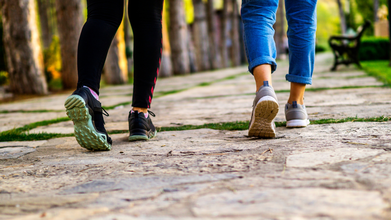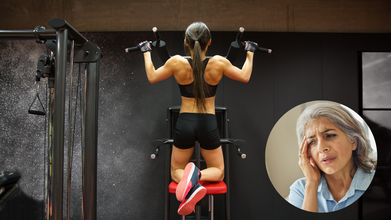- Health Conditions A-Z
- Health & Wellness
- Nutrition
- Fitness
- Health News
- Ayurveda
- Videos
- Medicine A-Z
- Parenting
- Web Stories
Working Out In The Evening: Is It Bad For Sleep And Health?

Image credit: Canva
My workouts for many years were morning-based. I quickly realized that juggling work, family, and a social life often meant my gym visits were less than consistent. I tried working out in the evenings. I assumed it would throw off my sleep or keep me up at night. Yet, I was amazed to discover that exercising at night did have its advantages, all things considered. This whole journey opened my eyes about the very complex relationship that exists between night exercise and sleep and, in extension, health.
Does It Impact Sleep?
It is widely known that regular physical activity promotes better sleep. Reducing anxiety, fostering relaxation, and helping normalize your body's internal clock all contribute to this effect. Physiologically, for example, exercise increases your core body temperature. Cooling down afterward sends you off into sleep as you feel yourself becoming drowsy.
Conventional wisdom had long told people that exercising near bedtime could jeopardize their sleep quality. But research challenges this narrative, showing even moderate-intensity workouts at evening hours may not impact negatively on sleep if carefully considered in terms of timing and intensity. It's understanding your body and how best to time exercises when done.
Benefits of Evening Workouts
If your lifestyle requires working out in the evening, don't worry; there are benefits to sweating it out late in the day. Here's a closer look at how nighttime exercise can impact your routine positively:
1. Improved Physical Performance
This suggests that muscle strength and flexibility peak later in the day because of the circadian rhythms governing the internal body clock. During the evening, higher body temperatures increase the function of the muscles, making physical activities more effective and enjoyable.
2. Stress Relief and Mental Refresh
Evening workouts can serve as a mental reset after a long day of deadlines, traffic, and errands. Exercise-induced endorphins help improve your mood, lower stress, and provide a sense of accomplishment that can buffer against future stress.
3. Less Crowded Gyms
Late-night gym-goers often find themselves with the luxury of empty spaces and uninterrupted access to equipment. It's the perfect opportunity to try new machines or workouts without feeling rushed.
4. Better Recovery
Contrary to the perception that late-night eating promotes weight gain, having a nutrient-dense snack such as a protein shake post-evening exercise will only help recovery. According to research, casein, which is a milk-based protein, will promote muscle repair and performance if taken before sleep.
5. Better Sleep for the Average Exercise
A mid-level intensity exercise, such as jogging or cycling, in the evening, one to two hours before sleep, can enhance the quality of slow-wave sleep, the most restorative sleep stage. This is however dependent on the avoidance of intense activities, such as HIIT, before sleeping.
Possible Disadvantages of Night Workouts
Evening workouts have numerous benefits, but they come with some drawbacks:
1. Sleep Disturbance Risk
High-intensity exercise should be done well before bedtime. Indeed, this can be way too stimulating for the nervous system and increase heart rate, which is a less-than-ideal situation going to bed. Intensive activities like heavy weight-lifting or sprinting might be better done in daylight hours.
2. Irregular Schedule
Evening schedules are often vulnerable to interruptions. Spontaneous plans, work deadlines, or sheer exhaustion after a long day can derail your commitment to exercising at night. Building consistency in your routine is essential to avoid skipping workouts.
Best Practices for Evening Exercise
To maximize the benefits of nighttime workouts and minimize potential downsides, follow these tips:
- Choose the Right Intensity: Opt for light to moderate-intensity activities such as yoga, leisurely biking, walking, or swimming. These activities are less likely to interfere with your sleep compared to high-intensity exercises.
- Time Your Workouts Wisely: Finish exercising at least 1–1.5 hours before bedtime to allow your body time to cool down and relax.
- Track your sleep: You could record sleep type and timing based on exercising and note their pattern changes; thus, it makes for a more fitting regime as per your need
How Much Exercise Do You Need?
Regular exercise, regardless of the time, is the foundation of good sleep and health. To achieve maximum benefits, one should engage in at least 150 minutes of moderate-intensity aerobic exercise per week. This can be divided into five 30-minute sessions or two 15-minute sessions a day. If you prefer to do high-intensity exercises, you should target 75 minutes per week but avoid doing them close to bedtime.
The best workout time is one that works for you and keeps you consistent. Some people do best on mornings, while others find their rhythm in the evening. Proper planning will help ensure that working out at night can improve both your physical and mental well-being without compromising sleep.
Each individual’s response to exercise varies, making it essential to listen to your body and experiment with different routines. Whether you’re winding down from a chaotic day or seizing the calm of a late-night gym, nighttime exercise might just be the key to unlocking better health and a peaceful night’s rest.
Long Walks Vs Several Short Walks? Study Reveals Which One Is Better For Your Health

(Credit-Canva)
Walking is said to be one of the best exercises. Not only is it an easy and accessible exercise, but it can be done anywhere and also does not need a lot of equipment. Many people aim for 10,000 steps a day as a sign of good health. But should you take one long walk, or multiple short ones? A new study has answered this question.
New research suggests that a single, longer walk each day is better for your heart than breaking up your steps into many short strolls, especially if you don't exercise regularly.
The study, published in Annals of Internal Medicine, found that walking for at least 15 minutes without stopping is ideal. This longer, steady pace, which is about 1,500 continuous steps gives your heart a much better workout.
Longer Vs Shorter Walks: Which is Better?
Researchers tracked the walking habits of over 33,500 adults in the UK who walked less than 8,000 steps a day. After tracking their health for eight years, the findings were clear:
Lower Heart Risk
People who consistently walked in longer, uninterrupted stretches had a lower risk of heart problems compared to those who only took short, quick bursts of steps.
Why Are Longer Walks Better For Health?
Even among the least active group (those walking under 5,000 steps daily), taking longer walks made a major difference. Their risk of heart disease and early death dropped significantly.
The researchers explain that most people focus only on the number of steps they take, but not the patterns. They suggests that even inactive people can boost heart health by changing their habits to walk for at least 10–15 minutes at a time.
Should People Focus More On How They Walk Or How Much?
Many people aim for 10,000 steps a day, but that number actually came from an old pedometer advertisement, not science. While experts agree more steps are generally good, this study emphasizes that how you walk matters more than just the total step count.
The researchers suggest that simple changes, like setting aside time specifically for a long walk, could make a big impact on heart health.
The NHS still recommends getting 150 minutes of moderate activity like brisk walking, each week, and ideally it should be spread out. For older adults, moving every day, even with light activity around the house, is key.
It's important to know that while the study shows a strong link between longer walks and better health, it doesn't definitively prove that walking directly causes the improvement.
However, health experts agree exercise is vital. They explain that you might find it hard at first, but it will get easier as your body adjusts. Even small improvements contribute to a healthy heart.
What Are Some Safety Tips for Walkers?
While walking is generally a safe activity, accidents can happen, especially if you like to walk alone. To stay safe while walking,
Be Visible
Wear bright, reflective clothing or carry a flashlight after dark or in dim light so drivers and others can easily spot you.
Stay Alert
Focus on your immediate surroundings; avoid distractions like your phone or headphones to always know what's happening around you, especially traffic.
Use Paths
Walk or bike only on marked paths, lanes, or sidewalks, and cross streets at designated crosswalks where vehicles are expecting pedestrians.
Donald Trump Health Update: First Hand Bruise, Now Swollen Ankle, Is The President Hiding A Health Crisis?

Credits: AFP/X
Donald Trump health has become a heated topic of debate and the concerns around his health has resurfaced after a photo from his Kuala Lumpur visit on Sunday, October 26, went viral. He was spotted with swollen ankles. The photo that went viral is from a meting of the Association of Southeast Asian Nations (ASEAN), which kicked off his six-day trip.
The pictures of his swollen ankle have flooded on social media and people are saying that his ankle is seen to be extremely swollen. As per experts, this happens due to chronic venous insufficiency, which is a condition Trump had earlier announced to be suffering from.

Chronic venous insufficiency occurs when the veins in the legs have trouble sending back to the heart. This causes blood to pool and creating high pressure. This is usually caused by damaged or weakened valves in the veins and is characterized by symptoms like leg swelling, aching, and heaviness, which improves with elevation. Risk factors include age, a history of deep vein thrombosis, and prolonged periods of sitting or standing.
However, Trump's latest physical test says something else. The White House physician Sean P Barbabella declared that the president "remains in exceptional health, exhibiting strong cardiovascular, pulmonary, neurological, and physical performance". Barbabella also stated that his "cardiac age was found to be approximately 14 years younger than his chronological age".
Trump's Legs Could Also Reveal That He Had A Stroke
As per a "Physical Therapist", who posts videos on Instagram by the username @epistemiccrisis with 74.2k followers, Trump also had his peroneal nerve paralyzed. He explains, "The deep branch of common peroneal nerve, which supplies a muscle known as the tibialis anterior, which blends your foot up toward your head when you walk. This is known as dorsiflexion. If this nerve is paralyzed, you would get a foot drop."
However, he notes that this can be easily remedied with a brace, called ankle foot orthosis or AFO. He said that the president was most likely wearing it as the outline of the posterior portion of "what looks like an AFO" could be seen through his pants.
Concerns On Trump's Health
Previously, the same "Physical Therapist" claimed that President Trump had a stroke. This is because he had difficulty walking in a straight line. In fact, a 2021 study published in journal Healthcare notes that stroke is a major cause of disability worldwide and balance impairments are common disabling factors in patients with stroke, which could lead to falls.
However, as per the official medical records of the president, no such strokes were mentioned. His medical report pronounced him in "excellent health". The examination was done at Walter Reed National Military Medical Center. The report also emphasized that Trump maintains a "demanding daily schedule without restriction". Not only that, the report has gone so far to declare Trump's cardiac age as 14 years younger than his actual age after an electrocardiogram.
This Simple Grip Test Could Predict Your Dementia Risk

Credits: Canva
Dr Peter Attia, physician, and researcher known for his work in longevity medicine believes that there is a correlation between your grip strength and dementia onset risk and dementia mortality.
Dr Attia says, "My best explanation for this is that grip strength is itself a proxy for overall strength. The type of strength we are talking about here is acquired, not inherited. You had to do a bunch of work to get it, and it is the work you did that is actually what's protect your brain."
He says that women who are over 40, must be able to hand on a bar for a minute and a half, and for men, it is two minutes. The key is that you are supposed to be able to carry 75% of your weight, he says, in an interview with CBS News' 60 minutes.
Is There Any Truth In The Claim That Grip Strength Has A Correlation With Dementia?
As per a 2021 study published in journal Frontiers in Aging Neuroscience, titled Grip Strength and the Risk of Cognitive Decline and Dementia: A Systematic Review and Meta-Analysis of Longitudinal Cohort Studies, loss of grip strength and cognitive impairment are prevalent in the elderly, and they may share the pathogenesis in common.
The study found that poorer grip strength was in fact associated with more risk of cognitive decline and dementia. The subgroup analysis within the study also indicated that people with poorer strength had more risk of Alzheimer's disease and non-AD dementia.
But why does this happen? Lower grip strength is a marker for overall muscle mass, general health, and is linked to the health of the brain and its blood vessels. This link is also connected to other factors like vascular health, cognitive decline, and physical activity, as low grip strength can be a symptom of poor overall physical and metabolic health.
How Is Lower Grip Strength Is Linked To Dementia?
Indicator Of Overall Health: Grip strength reflects the health of entire body, this is why a lower grip strength is an indicate of lower muscle mass, and general poor health.
Vascular and brain health: Since there is a connection between muscle strength, blood flow, and brain health, thus lower grip strength is associated with a higher risk of vascular dementia and a greater volume of white matter hyperintensities in the brain.
Also Read: What Home Gym Tools Can Help You Stay Fit Without Hitting The Gym?
Poorer grip strength is associated with lower cognitive function, such as fluid intelligence and prospective memory. This suggest a link between the body's physical capabilities and the brain's cognitive abilities.
A different study published in 2022, where 40,000 participants from the UK Biobank were studied found that greater grip strength was associated with better cognitive functioning, higher life satisfaction, greater subjective well-being, and reduced depression and anxiety symptoms while controlling for numerous demographic, anthropometric, and socioeconomic cofounders.
The study also found that grey matter volume of subcortical region also correlated with better mental health and considerably mediated their relationship with grip strength.
© 2024 Bennett, Coleman & Company Limited

